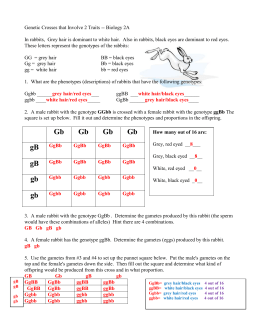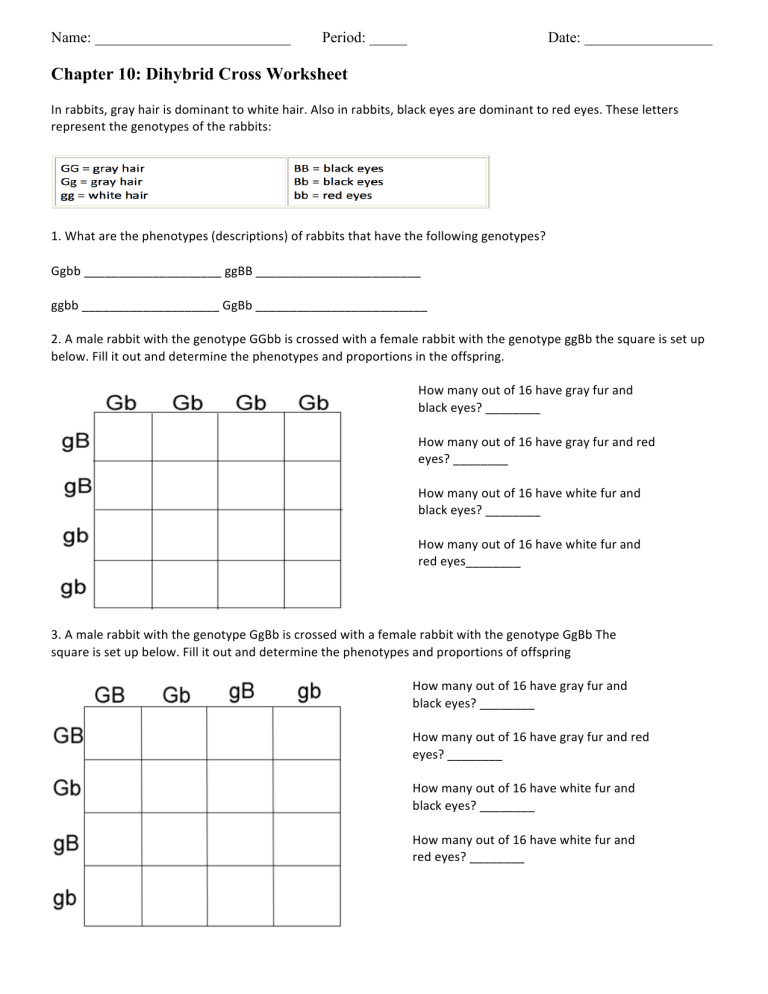As a high school biology student, I vividly remember the first time I encountered a dihybrid cross problem. It felt like a tangled mess of letters and probabilities. I couldn’t grasp how to follow the inheritance patterns of two traits simultaneously. But then, a click! Everything started to make sense when I understood the underlying principles and learned how to use a Punnett square. In this article, we’ll embark on a journey exploring the world of dihybrid crosses, demystifying the solutions to those seemingly complex worksheet problems.

Image: studylib.net
Understanding dihybrid crosses lays the foundation for comprehending the complexities of inheritance. It helps us unravel how multiple genes interact and influence the traits passed down from parents to offspring. By mastering this concept, we can better appreciate the diversity of life and the role genetics plays in shaping our world.
Decoding the Dihybrid Cross: A Two-Trait Adventure
A dihybrid cross is a genetic cross that involves the inheritance of two distinct traits. Unlike a monohybrid cross that focuses on a single trait, dihybrid crosses delve into the complexities of how two different genes, each with two alleles, are transmitted from one generation to the next.
Visualizing a dihybrid cross is made easier with the help of Punnett squares, a tool that graphically represents the possible combinations of alleles for each trait. Each parent contributes one allele for each trait, and the Punnett square helps us visualize all possible combinations of those alleles in the offspring.
Bridging the Gap: From Monohybrid to Dihybrid Crosses
Before diving into the intricacies of dihybrid crosses, let’s recap the basics of monohybrid crosses. In monohybrid crosses, we analyze the inheritance of a single trait governed by two alleles. For instance, we might examine the inheritance of flower color in pea plants, where one allele determines purple flowers (P) and the other determines white flowers (p).
Now, imagine adding another trait to the mix, like seed shape. Let’s say the alleles for seed shape are round (R) and wrinkled (r). A dihybrid cross would then concern the inheritance of both flower color and seed shape simultaneously.
Unraveling the Possibilities: The Significance of Independent Assortment
The key to understanding dihybrid crosses lies in the concept of independent assortment. This principle states that the alleles for different traits segregate independently of each other during gamete formation. This means the inheritance of flower color doesn’t influence the inheritance of seed shape, and vice-versa.
Think of it like shuffling a deck of cards. Each card represents an allele, and the shuffling represents the random assortment of alleles during meiosis. The combination of alleles in each gamete is independent of the combination in other gametes.

Image: hombregris-quico.blogspot.com
Walking Through a Dihybrid Cross: A Step-by-Step Guide
Let’s break down the steps involved in solving a dihybrid cross problem, using the example of flower color and seed shape in pea plants:
- Identify the Parental Genotypes: Start by identifying the genotypes of the parents. For example, one parent could be heterozygous for both traits (RrYy), while the other parent could be homozygous recessive for both traits (rryy).
- Determine the Possible Gametes: Each parent can produce four different gametes. Using the above example, the RrYy parent can produce RY, Ry, rY, and ry gametes, while the rryy parent can only produce ry gametes.
- Construct the Punnett Square: Draw a Punnett square with the gametes of one parent across the top row and the gametes of the other parent down the left column. Fill in the square with the resulting genotypes of the offspring.
- Analyze the Phenotype Ratios: After the Punnett square is completed, count the number of individuals with each possible phenotype (e.g., round yellow seeds, round green seeds, wrinkled yellow seeds, wrinkled green seeds).
- Interpret the Results: The phenotypic ratios of the offspring will give you a clear picture of how the traits have been transmitted.
Mastering Dihybrid Crosses: Tips and Tricks for Success
Dihybrid cross problems can initially seem daunting. But by following these tips, you’ll be well on your way to mastering them with confidence:
- Visual Aids: Utilize Punnett squares diligently. It’s the most effective way to represent all possible combinations of alleles.
- Foil Method: Employ the FOIL method (First, Outer, Inner, Last) to help you determine the possible gametes a parent can produce.
- Practice, Practice, Practice: The more problems you solve, the more comfortable you’ll become with recognizing patterns and applying the concepts.
- Understand the Terminology: Be familiar with terms like phenotype, genotype, allele, homozygous, heterozygous, and dominant/recessive.
- Break It Down: If a problem seems overwhelming, focus on one trait at a time. Analyze the inheritance of one trait, then move on to the other.
Frequently Asked Questions on Dihybrid Crosses
Here are some common questions students ask about dihybrid crosses:
Q1: What is the difference between a monohybrid cross and a dihybrid cross?
A monohybrid cross involves the inheritance of one trait, while a dihybrid cross involves the inheritance of two traits. Both crosses are useful for understanding the principles of Mendelian inheritance.
Q2: How do I know which alleles are dominant and recessive?
The dominance relationship between alleles is typically provided in the problem statement. If you’re working with a real-world example, you may need to consult a genetics textbook or database to determine the dominance relationships between specific alleles.
Q3: Can we predict the exact genotypes and phenotypes of all offspring in a dihybrid cross?
While we can predict the probabilities of different genotypes and phenotypes, we can’t predict the specific genotype or phenotype of each individual offspring. This is due to the random segregation and assortment of alleles during meiosis.
Q4: How can dihybrid crosses help us understand real-world phenomena like human genetic disorders?
Dihybrid crosses provide a framework for understanding the inheritance patterns of genetic disorders, many of which are caused by interactions between multiple genes. By analyzing family pedigrees and studying the inheritance of these disorders, genetic researchers can gain insights into the underlying genetic mechanisms.
Q5: What are some interesting applications of dihybrid crosses in agriculture and medicine?
In agriculture, dihybrid crosses are utilized to develop crops with desirable traits like increased yield, resistance to pests, or improved nutritional value. In medicine, dihybrid crosses are used to study the inheritance of genetic disorders and develop diagnostic tools and treatments.
Chapter 10 Dihybrid Cross Worksheet Answers
https://youtube.com/watch?v=23GOqNizVy0
Unlocking the Mysteries of Genetics: A Call to Action
Dihybrid crosses may seem complex at first glance, but with patience, practice, and a willingness to explore the world of genetics, you’ll unlock the mysteries of inheritance and gain a deeper understanding of the fascinating science behind how life works. Are you ready to delve even deeper into genetic principles and solve more challenging problems? We encourage you to explore further and uncover the hidden wonders of this fascinating field.





